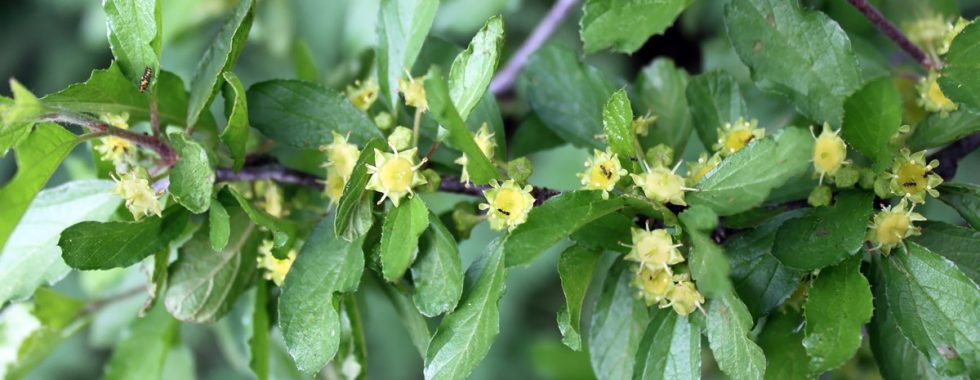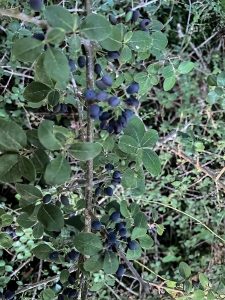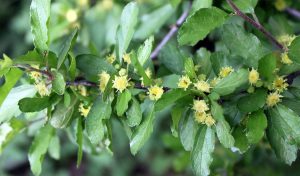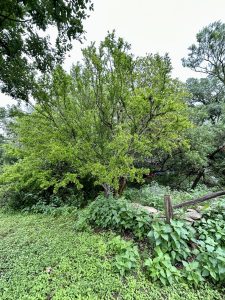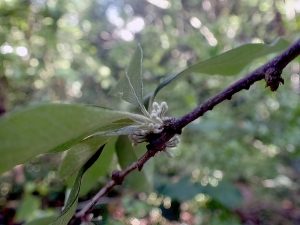Trail Notes: Mysteries in the Landscape
One advantage of occupying the same house for 45 years is the ability to answer the question “What would be living here if we weren’t?” The Ring camera on our deck gives us a pretty good idea of the wildlife that already inhabits this place: the armadillos and skunks, the possums and raccoons, the foxes and the deer.
What’s harder to imagine are the plants. The oaks and cedar elms are obvious, of course, as are the Mexican persimmons, the Mexican buckeyes, the evergreen sumacs, the Ashe junipers. More difficult to anticipate are the myriad understory trees and shrubs that dot our little landscape.
Sometimes it takes years to discern what’s coming up in a particular spot. Thus, my philosophy has always been to wait and see before yanking anything out. More often than not, that approach has served me well. Waiting, for example, allowed a volunteer orange tree to establish itself not far from our front door. It also gave me the Texas ebony that grew from a seed I’d forgotten I stuck in the ground.
Other plants, natives to the Texas Hill Country, took years to reveal their identities to me. Nondescript as they are, they probably wouldn’t last long in most suburban landscapes, but I’ve come to admire them for their subtlety, as well as for the important role they play in the ecosystem of my yard.
The first and most ubiquitous of these is Elbowbush (Forestiera pubescens), a drab gray-green shrub known for its wonky habit of growth. Also known as desert olive, New Mexico privet, and Texas forsythia, Elbowbush gets its name from the weird angles at which the branches grow; picture a human arm bent at the elbow, and you get the idea. These plants can be found in almost every shady corner of my yard, including the woods. They might be of no interest at all, except for a few key attributes. They are among the earliest shrubs to bloom in the spring, their inconspicuous flowers being a favorite of bees and butterflies; they produce a small, tasty berry that the birds devour; their foliage turns a chartreuse yellow in the fall; and they make an excellent hedge, along with the coralberry, to line the paths in front of our house. They’re also very forgiving plants, able to tolerate just about any kind of weather, sun, or soil type. In short, they’re definitely a keeper.
Equally plentiful in our yard is hog plum (Colubrina texensis), also fondly known as Texas snakewood. It’s the “smooth gray wood, with scaly brown markings” that gave this plant one of its names, Sally Wasowski explains in Texas Native Plants; its popularity with javelina gave it the other. Wasowski goes on to make a statement that puzzled me for years: “The entire shrub, I’m told, makes most landscape architects rhapsodic.” That might be stretching things a bit, given that hog plum can become unwieldy if not pruned regularly, and it can reproduce quite aggressively. That said, it is drought and disease tolerant, it grows in just about any soil, and it makes a fine hedge—say, along one side of our driveway. It can reach 6 feet or so, if you need a privacy screen, but it doesn’t mind shearing. Most important, birds and mammals consume its fruit, and the shrub itself is important habitat for wildlife. Says native plant specialist Jill Nokes, “The glossy leaves and interesting bark make hog plum a worthy ornamental shrub for hot dry locations.” Like our driveway.
Like hog plum, brasil (Condalia hookeri) is also a member of the buckthorn family. Unlike its cousin, however, brasil occurs less commonly in our yard. Indeed, it grows in only one spot, and its identity eluded me for years. For starters, it isn’t kind to visitors curious about what it is; get too close in your examination and you’ll discover the stiff thorns that protrude from almost every surface of the tree. I say “tree” because ours is probably 15 feet tall—the usual limit of its growth, though I’ve read it can reach 30 feet. What makes this tree a keeper is its value for wildlife. Birds, along with the gray fox and raccoon, are partial to the fruit, and pollinators appreciate the inconspicuous flowers that bloom from March through October. Sally Wasowski explains, “Since it flowers regularly, the fruits are always at various stages of ripeness. It’s not unusual to find, on the same branch, fruits that range from pale green to yellow to orange to wine-red to blue-black; birds quickly grab the ripe ones.” Brasil is a larval plant for the snout butterfly, and its thicket-forming habit makes it good cover for wildlife. Also known as bluewood condalia, the plant was so named because of the blue dye that can be made from the wood. Almost evergreen, the tree puts on attractive lime green leaves just as the old ones are falling off.
The first time I saw bumelia (sideroxylon lanuginosum), aka gum elastic tree or chittamwood, I thought I was looking at some sort of oak. But then there were those thorns. Texas A&M Agri Life Extension describes the tree in this way: “Chittamwood is a native, semi-evergreen, medium-sized tree that commonly grows with multiple trunks. It can reach heights of greater than 48 feet or 14.5 m. The dark green leaves are oblong and resemble those of a live oak. Its bark is gray to brown, and the branches have sharp spines at the ends.” In spite of those spines, bumelia, as I prefer to call it, has a lot going for it. Because of its long tap root, it is very drought resistant and can grow in a wide range of soil types. Bees are attracted to its small, fragrant flowers, which bloom in June and July, while birds and deer eat the fruit. Jill Nokes calls it “appropriate for situations too small or harsh for live oaks or other tall evergreen specimen plants.” In our case, bumelia is growing in a copse among an evergreen sumac, Mexican persimmon, and cedar elm. And it’s spreading, no doubt in an attempt to create a thicket of its own.
What these four species have in common isn’t hard to see: they’re tough, their flowers are underwhelming but important to pollinators, their fruits are eaten by both birds and other wildlife, they spread easily, and in several cases, they’re equipped with serious thorns. I should add that while they’re not on very many gardeners’ wish list, I’m awfully glad to have them.
** Note: Although these plants are growing in my yard, I neither planted nor tended them with care. So don’t be surprised if you spot one of them growing with gusto along a trail in the natural areas.
Written by Susan Hanson, editor of The Loop.

